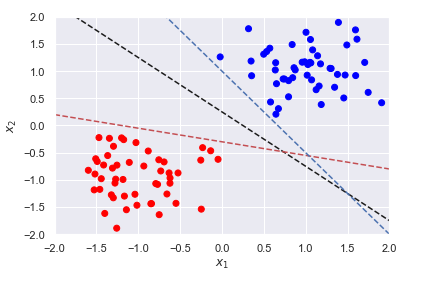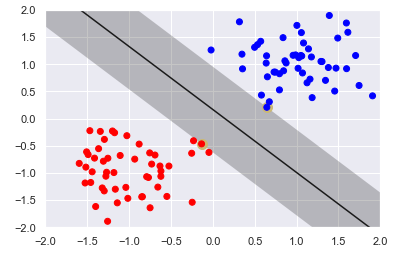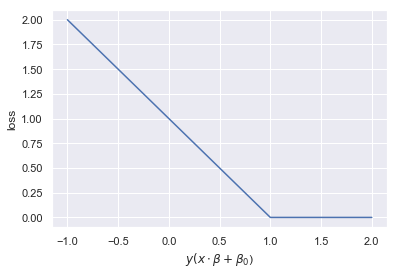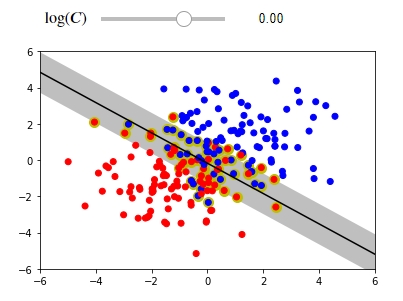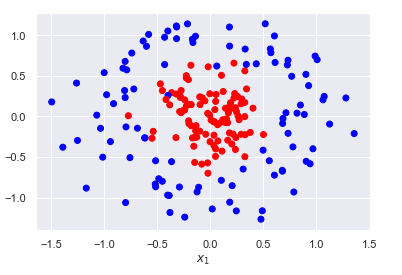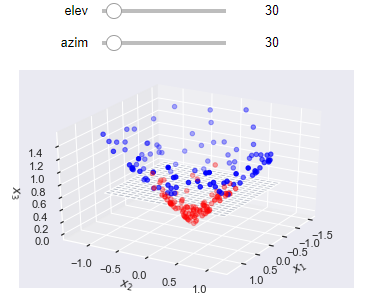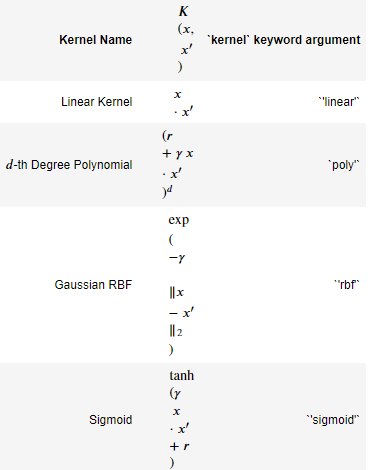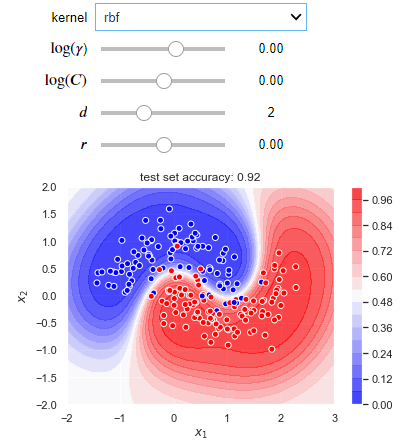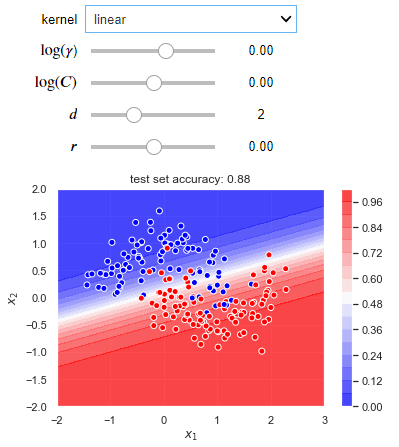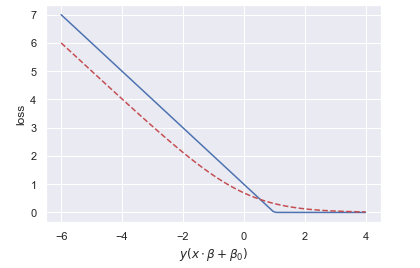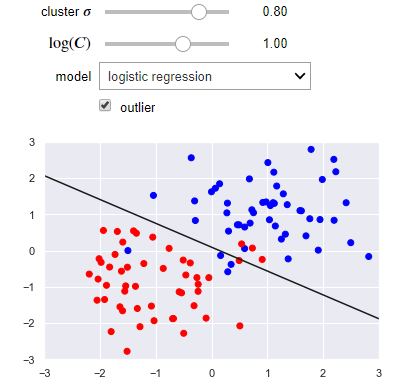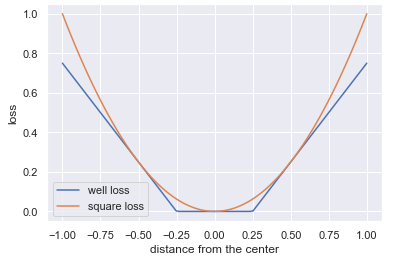
Open-Source Internship opportunity by OpenGenus for programmers. Apply now.
Support vector machines are a popular class of Machine Learning models that were developed in the 1990s. They are capable of both linear and non-linear classification and can also be used for regression and anomaly/outlier detection. They work well for wide class of problems but are generally used for problems with small or medium sized data sets. In this tutorial, we will start off with a simple classifier model and extend and improve it to ultimately arrive at what is referred to a support vector machine (SVM).
Hard margin classifier
A hard margin classifier is a model that uses a hyperplane to completely separate two classes. A hyperplane is a subspace with one less dimension as the ambient space.
- In two dimensions, a hyperplane is a one dimension subspace namely a line.
- In three dimensions, a hyperplane is a flat two dimension subspace namely a plane.
- In a p dimensional space, a hyperplane is a flat affine subspace of p-1 dimension.
It is helpful to consider each observation in our data set as existing in a 𝑝 -dimensional space where 𝑝 is the number of features (columns) in our data. A hyperplane is simply a generalization of a plane in 𝑝 -dimensional spaces.Here, we plot three such hyperplanes to separate two classes.
from sklearn.datasets import make_blobs
X, y = make_blobs(centers=[[1, 1], [-1, -1]], cluster_std=0.4, random_state=0)
x = np.linspace(-2, 2, 100)
plt.scatter(X[:, 0], X[:, 1], c=y, cmap=plt.cm.bwr)
plt.plot(x, -x+0.25, '--k')
plt.plot(x, -0.25*x-0.3, 'r--')
plt.plot(x, -1.5*x+1, 'b--')
plt.xlim([-2, 2])
plt.ylim([-2, 2])
plt.xlabel('$x_1$')
plt.ylabel('$x_2$');
Output:
We not only want a classifier that will completely separate both classes but one that is situated an equal distance from the two classes. Such a classifier will likely be a better decision boundary for new data. Our model should not only seek for complete separation of our classes but also create the largest margin between the two classes. To find the classifier that results in the largest margin, we need to first define the equation of a hyperplane and understand how to calculate distances. The equation for a 𝑝 -dimensional hyperplane is 

Determining the maximum margin
For a given problem, there could be various hyperplanes that satisfy the above inequality; the three classifiers shown above all satisfy the inequality. We want a classifier that creates the largest possible margin; we will need to include the following constraint,


from ipywidgets import interact, IntSlider, FloatSlider, fixed
def plot_svc_interact(X, y):
def plotter(log_C=1):
clf = svm.SVC(C=10**log_C, kernel='linear')
clf.fit(X, y)
beta = clf.coef_[0]
beta_0 = clf.intercept_
slope = -beta[0]/beta[1]
intercept = -beta_0/beta[1]
x_max = np.ceil(np.abs(X).max())
x = np.linspace(-x_max, x_max, 100)
margin_bound_1 = 1/beta[1] + slope*x + intercept
margin_bound_2 = -1/beta[1] + slope*x + intercept
plt.plot(x, slope*x + intercept, 'k')
plt.fill_between(x, margin_bound_1, margin_bound_2, color='k', alpha=0.25, linewidth=0)
plt.scatter(*clf.support_vectors_.T, s=100, c='y')
plt.scatter(X[:, 0], X[:, 1], c=y, cmap=plt.cm.bwr)
plt.axis([-x_max, x_max, -x_max, x_max])
return plotter
plot_svc_interact(X, y)(log_C=2)
Output:
The figure displays the largest margin possible without having vectors inside the margin. The figure highlights two vectors, the vectors that prevent the margin from expanding. These vectors are referred to as support vectors because they support the margin structure. You can think of the margin boundaries as a wall or fence and the support vectors help maintain or support the structure. The support vectors are the only vectors in the training set that influences the choice of hyperplane. Changing the values of the other vectors will not affect the margin, so long as they still stay out of the margin.
Soft margin classifier
Not all cases is it possible to completely linearly separable the two classes. We need to relax the constraint that there be no margin violations. The result is what is called the soft-margin classifier. As before, we still look to create the largest possible margin but the model will incur a penalty for vectors that reside in the margin or are on the wrong side of the hyperplane. Mathematically, we are going to construct a margin such that

Each vector will have its own value of 𝜁 . If a vector does not reside inside the margin and is on the right side of the hyperplane, then 𝜁=0 and we have the constraint for our hard margin classifier. These vectors will contribute to the cost function we want to minimize. If a vector is inside the margin, then 𝜁 needs to be greater than 0 to still satisfy the constraint. If a vector lies on the hyperplane, then 𝑥𝑗⋅𝛽+𝛽0=0 and 𝜁 must be at least equal to 1 to satisfy the constraint. If the vector is on the wrong side of the hyperplane, then 𝜁 for that vector needs to be greater than 1.
Determining the hyperplane coefficients of the soft margin classifier involves solving a convex quadratic minimization with linear constraints. It can solved using quadratic programming solvers and the time complexity will be 𝑂(𝑛𝑝) . The soft-margin classifier in scikit-learn is available using the svm.LinearSVC class.
The soft margin classifier uses the hinge loss function, named because it resembles a hinge. There is no loss so long as a threshold is not exceeded. Beyond the threshold, the loss ramps up linearly. See the figure below for an illustrations of a hinge loss function. Negative distance means the observation is on the wrong side of the hyperplane.
x = np.linspace(-1, 2, 100)
hinge_loss = lambda x: -(x-1) if x-1 < 0 else 0
plt.plot(x, list(map(hinge_loss, x)))
plt.xlabel("$y(x\cdot\\beta + \\beta_0$)")
plt.ylabel('loss');
Output:
We will train the soft margin classifier on a data set that is not completely linear separable. If you try to run this code on your IDEs ,the interactive visualization allows you to modify the hyperparameter 𝐶 . Consider the effect of increasing and decreasing 𝐶 . Note, for tuning purposes, it's best to use a logarithmic scale.
from sklearn.datasets import make_blobs
X, y = make_blobs(centers=[[1, 1], [-1, -1]], cluster_std=1.5, random_state=0, n_samples=200)
log_C_slider = FloatSlider(min=-4, max=2, step=0.25, value=0, description='$\log(C)$')
interact(plot_svc_interact(X, y), log_C=log_C_slider);
Kernels for non-linear classification
Using a hyperplane to separate the two classes will have limited performance as most problems require a non-linear decision boundary. One approach to overcome this limitation is to engineer non-linear features using the original features. Essentially, we are projecting our data onto a higher dimensional space where a linear classifier will perform substantially better. Consider the example below.
from sklearn.datasets import make_circles
X, y = make_circles(n_samples=200, noise=0.2, factor=0.25, random_state=0)
plt.scatter(*X.T, c=y, cmap=plt.cm.bwr)
plt.xlabel('$x_1$')
plt.ylabel('$x_2$');
We clearly cannot linearly separate the two classes. However, we can create a new feature
from mpl_toolkits.mplot3d import Axes3D
def plot_projection(X, y):
XX, YY = np.meshgrid(np.linspace(-1, 1, 20), np.linspace(-1, 1, 20))
ZZ = 0.6*np.ones((20, 20))
x_3 = (X[:, 0]**2 + X[:, 1]**2)**0.5
X_new = np.hstack((X, x_3.reshape(-1, 1)))
def plotter(elev=30, azim=30):
fig = plt.figure()
ax = plt.axes(projection='3d')
ax.scatter(*X_new.T, c=y, cmap=plt.cm.bwr)
ax.plot_surface(XX, YY, ZZ, alpha=0.2);
ax.view_init(elev, azim)
ax.set_xlabel('$x_1$')
ax.set_ylabel('$x_2$')
ax.set_zlabel('$x_3$')
return plotter
interact(plot_projection(X, y), elev=(0, 360), azim=(0, 360));
In this higher dimension, it is possible for a hyperplane to adequately divide the two classes. The resulting decision boundary on the original, lower dimensional space, is non-linear.
In the example, we introduced the new non-linear term directly into data set. However, the way the objective function is solved allows us to indirectly applying the projection, using what is called the kernel trick. A kernel is a function that creates the implicit mapping/projection to a higher dimensional space. The advantage of using a kernel trick are:
- No direct feature generation that increases the size of the data set.
- We can readily swap out and try different kernels to see which one performs the best.
With the kernel, we can now refer to our model as a support vector machine.
Choices of Kernel
There are several popular choices of kernels; they are the polynomial, sigmoid, and Gaussian radial basis function (RBF). In scikit-learn, the choice of kernel is controlled by the keyword argument kernel. The table below
Usually, the radial basis function kernel will perform the best and there's only one additional hyperparameter to tune, 𝛾 . An interesting note is that using the radial basis function kernel is equivalent to projecting our vectors to an infinite dimensional space. It would not be possible to use the radial basis function kernel without the kernel trick.
The following blocks of code create an interactive visualization where you can experiment with different kernels and hyperparameter values for a situation where a non-linear decision boundary is required. Try to run this code into your IDEs, it will give you better learning experience.
def plot_decision_boundary(X_train, X_test, y_train, y_test):
def plotter(kernel='linear', log_gamma=1, log_C=1, deg=1, coef0=1):
clf = svm.SVC(C=10**log_C, kernel=kernel, gamma=10**log_gamma, coef0=coef0, probability=True)
clf.fit(X_train, y_train)
X1, X2 = np.meshgrid(np.linspace(-2, 3), np.linspace(-2, 2))
y_proba = clf.predict_proba(np.hstack((X1.reshape(-1, 1), X2.reshape(-1, 1))))[:, 1]
plt.contourf(X1, X2, y_proba.reshape(50, 50), 16, cmap=plt.cm.bwr, alpha=0.75)
plt.colorbar()
accuracy = clf.score(X_test, y_test)
plt.scatter(X_train[:, 0], X_train[:, 1], c=y_train, edgecolors='white', cmap=plt.cm.bwr)
plt.xlabel('$x_1$')
plt.ylabel('$x_2$')
plt.title('test set accuracy: {}'.format(accuracy));
return plotter
from sklearn.datasets import make_moons
from sklearn.model_selection import train_test_split
X, y = make_moons(400, noise=0.25, random_state=0)
X_train, X_test, y_train, y_test = train_test_split(X, y, test_size=0.5, random_state=0)
log_C_slider = FloatSlider(min=-4, max=4, step=0.25, value=0, description='$\log(C)$')
log_gamma_slider = FloatSlider(min=-3, max=2, step=0.01, value=0, description='$\log(\gamma$)')
deg_slider = IntSlider(min=1, max=4, step=1, value=2, description='$d$')
coef0_slider = FloatSlider(min=-100, max=100, step=0.1, value=0, description='$r$')
interact(plot_decision_boundary(X_train, X_test, y_train, y_test),
log_C=log_C_slider,
log_gamma=log_gamma_slider,
kernel=['rbf', 'linear', 'sigmoid', 'poly'],
deg=deg_slider,
coef0=coef0_slider);
Output:
Comparison with logistic regression
The SVM models resembles that of logistic regression. They are both linear binary classifiers, if we ignore the kernelized version. The difference between the two methods is the cost function they use to determine model parameters. The logistic regression uses the log loss while SVM uses the hinge loss. Both functions are plotted below.
x = np.linspace(-6, 4, 100)
hinge_loss = lambda x: -(x-1) if x < 1 else 0
log_loss = np.log(1+np.exp(-x))
plt.plot(x, list(map(hinge_loss, x)))
plt.plot(x, log_loss, '--r')
plt.xlabel("$y(x \cdot \\beta + \\beta_0)$")
plt.ylabel('loss');
Output:
The two cost functions have the same limiting behavior.
- If an observation is on the correct side of the hyperplane and very far away, large positive value of 𝑦(𝑥⋅𝛽+𝛽0) , it will have nearly zero loss for the log loss and exactly zero for the hinge loss.
- If an observation is on the wrong side of the hyperplane and very far away, large negative value of 𝑦(𝑥⋅𝛽+𝛽0) , the log loss penalty is linear with respect to the distance to the hyperplane. The hinge loss penalty is always linear.
The matching limiting behavior, as 𝑧→±∞ , can be observed in the equations for the loss functions,The difference occurs in the intermediate zone. SVM uses a threshold; if the observation is not inside the margin and on the right side of the hyperplane, there is no penalty. It does not matter how far away from the hyperplane the observation is located, so long as it still on correct side and not in the margin. This allows for the model to generalize better. For logistic regression, there will always be non-zero loss. Since every observation will have a cost, the model will need to "satisfy" each observation with regards to where to locate the hyperplane. Logistic regression will hurt the models ability to generalize. Note, a regularization term is often added to the logistic regression cost function, helping it generalize. Despite these differences, logistic regression and linear SVM often achieve similar results.
Here are some things to consider when choosing which of the two models to use. - If calculating probabilities is important, use logistic regression as it is a probabilistic model.
- If the data is sufficiently linearly separable, both models can be used but SVM may work better in the presence of outliers.
- If the two classes are not linearly separable, use SVM with a kernel.
- If there is a large number of observations, 50,000 - 100,000, and a small number of features, it is best to manually create new features and use logistic regression or linear SVM. Kernelized SVM is slow to train with large number of observations.
The following visualization lets you use either a linear regression or SVM. You can control the separation of the clusters as well as the presence of an outlier. Notice how the SVM works better than linear regression when there is an outlier.
from sklearn.linear_model import LogisticRegression
def plot_svc_vs_lr(cluster_std=0.8, log_C=1, model='logistic regression', outlier=False):
X, y = make_blobs(centers=[[1, 1], [-1, -1]], cluster_std=cluster_std, random_state=0)
if outlier:
X = np.vstack((X, [-1.5, 0.]))
y = np.hstack((y, [0]))
name_to_clf = {'logistic regression': LogisticRegression(C=10**log_C, solver='lbfgs'),
'SVM': svm.SVC(C=10**log_C, kernel='linear')}
clf = name_to_clf[model]
clf.fit(X, y)
beta = clf.coef_[0]
beta_0 = clf.intercept_
slope = -beta[0]/beta[1]
intercept = -beta_0/beta[1]
x_max = np.ceil(np.abs(X).max())
x = np.linspace(-x_max, x_max, 100)
plt.plot(x, slope*x + intercept, 'k')
plt.scatter(X[:, 0], X[:, 1], c=y, cmap=plt.cm.bwr)
plt.axis([-x_max, x_max, -x_max, x_max])
log_C_slider = FloatSlider(min=-4, max=4, step=0.25, value=1, description='$\log(C)$')
cluster_std_slider = FloatSlider(min=0.2, max=1.0, step=0.05, value=0.8, description='cluster $\sigma$')
interact(plot_svc_vs_lr,
cluster_std=cluster_std_slider,
log_C=log_C_slider,
model=['logistic regression', 'SVM']);
Output:
SVM for regression
SVMs can be also be used for regression with some modifications to the constrained optimization. Instead of constructing a margin that avoids penalties incurred by vectors residing inside the margin, we train a model that includes as many vectors inside the margin as possible. Now, vectors that are inside the margin carry no penalty but will incur one if they are outside of the margin. Similarly as before, the penalty ramps up linearly the farther away the vector is from the edge of the margin. Instead of a hinge loss, the SVM regressor uses a well-loss cost function, shown below
eps = 0.25
x = np.linspace(-1, 1, 100)
well_loss = list(map(lambda x: abs(x)-eps if abs(x) > eps else 0, x))
square_loss = x**2
plt.plot(x, well_loss)
plt.plot(x, square_loss)
plt.xlabel('distance from the center')
plt.ylabel('loss')
plt.legend(['well loss', 'square loss']);
Output:
Lagrangian dual formulation
Instead of solving the originally formulated optimization problem, we can reformulate the problem to construct what is called a dual problem. The original formulation is referred to as the primal. We can use Lagrangian multipliers which transforms the constrained minimization problem into an unconstrained problem. Under certain conditions, the solution to solving the dual problem is the same as solving if we had solved the primal. These conditions are met with our original quadratic optimization with linear constraints. Thus, we can either solve the primal or dual problem and get the same result.
The dual formulation of the soft-margin classifier is

The kernel trick
As discussed earlier, you can introduce new non-linear terms into your data set directly. For example, if you have two features 𝑥1 and 𝑥2 , you can introduce polynomial terms. The dual formulation that applies the mapping to generate non-linear features is
where ℎ(𝑥𝑗) is a function that projects the original vectors to the new higher dimensional space. However, if we have a large set of features, the number of new features will become too many, even if we only include terms of degree 2. In the dual formulation, only the result of the dot product of the vectors matter. Instead of expanding the dimensions of our vectors and then taking the dot product, we can pose a function 𝐾 such that
This function is referred to as a kernel. The result of using a kernel on the dot product of the vectors in the original space is mathematically equivalent to explicitly transforming our vector and then taking the dot product. The kernel function is indirectly applying the feature transformation and avoids the creating vectors of very large dimensions. The advantage of solving the problem using the dual formulation is that it allows for the use of the kernel trick. With the kernel, we can now refer to our model as a support vector machine. The kernelized form of the equation we want to minimize is
Solving for the hyperplane coefficients using the dual formulation is 𝑂(𝑛2𝑝) to 𝑂(𝑛3𝑝) . The training time complexity does not scale well with increasing number of observations. Because of training time complexity of SVMs, they are not useful when working with large data set. There is no hard cutoff, but scikit-learn recommends against using a SVM with a data set of more than 100,000 samples. The class svm.SVC provides the kernelized form of the model, solved using the dual formulation.
With this article at OpenGenus, you must have a good idea of Support Vector Machines in Machine Learning. Enjoy.
